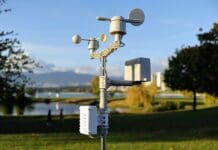This post is also available in:
 עברית (Hebrew)
עברית (Hebrew)
It seems as though drone technology has been advancing exponentially over the past decade, to the point where it has become hard to imagine what the next generation of drones will look like. For the most part, modern drones and UAVs resemble modern planes and helicopters, with a mild exception existing in quadcopters. However the Phoenix, a new drone developed by CPI in the United Kingdom, is one of a kind with its reminiscent blimp shape.
The 49 foot long and 34 foot wide drone looks like a mix between a blimp and a modern era UAV. The Phoenix gets most of its energy supply from solar panels placed on its wings.
Unlike most other flying contraptions in the modern world, the Phoenix moves through the air using a “variable-buoyancy propulsion system.” In order to move forward, the Phoenix sucks in air and stores it within an inflatable bag. This extra weight causes the drone to lose altitude. The wings then convert this loss in altitude into forward motion.
The Phoenix then could release some air, causing the drone to regain the altitude lost. The drone also has a supply of either helium or hydrogen in order to provide extra buoyancy. Since it lacks an internal combustion motor and the need for fuel, the Phoenix could theoretically float indefinitely in the sky.
Popularmechanics.com describe the aircraft’s wings being made of carbon fiber, and the fuselage constructed out of Vectran. The aircraft is so inexpensive that its developers describe the Phoenix as nearly disposable.
The unmanned blimp has been in development for three years, during this time a wide range of military uses have been proposed for the Phoenix. Since it can practically float around indefinitely, the Phoenix could act as a floating sensor or communications node. More specifically, it can be used to provide secure line of sight communications in situations where satellites are not available or secure for any reason.
The aircraft could also work as an intel gathering, sensor platform. The Phoenix could hover over areas and track movements using cameras and sensors, as well as potentially disrupt enemy communications. And since the Phoenix is so cheap to produce, militaries around the world could hold on to a large number of the drone and deploy them whenever necessary.


























